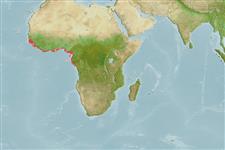Classification / Names
Common names from other countries
Main reference
Size / Weight / Age
Max length : 47.0 cm TL male/unsexed; (Ref. 5752); common length : 30.0 cm TL male/unsexed; (Ref. 3593)
Length at first maturity
Lm 19.1 range ? - ? cm
Environment
Marine; brackish; demersal; depth range 0 - 100 m (Ref. 3593), usually 50 - 100 m (Ref. 26999)
Climate / Range
Tropical, preferred 26°C (Ref. 107945); 17°N - 6°S, 17°W - 14°E (Ref. 54743)
Distribution
Short description
Dorsal
spines
(total): 11;
Dorsal
soft rays
(total): 29-34;
Anal
spines: 2;
Anal
soft rays: 6. Diagnosis: medium-sized fish, fusiform and compressed; head short; eyes rather large; snout short; mouth large and oblique, subterminal; teeth villiform, set in narrow bands in both jaws; 5 marginal pores on snout and 6 mental pores; gill rakers long and slender, longer than gill filaments at angle of first gill arch; dorsal fin long, deeply notched; 2nd anal fin spine very strong, about as long as 1st soft ray and comprised less than twice in head length; caudal fin more or less pointed; scales ctenoid on body, cycloid on breast and head; lateral line extending to hind margin of caudal fin; swim bladder carrot-shaped, its front end with a pair of appendages subdividing into a group of short anterior branches and a bundle of 5-6 slender tubes extending backwards over half the length of swim bladder (Ref. 57396).
Coloration: back olivaceous brown, sides silvery with series of dark dots, belly light, yellowish during reproduction period; spinous part of dorsal fin dark, soft part lighter, with 2-3 longitudinal series of dark dots; pelvics and anal fin yellowish (Ref. 57396).
IUCN Red List Status (Ref. 115185)
Threat to humans
Harmless
Human uses
Fisheries: commercial; gamefish: yes
More information
ReferencesAquacultureAquaculture profileStrainsGeneticsAllele frequenciesHeritabilityDiseasesProcessingMass conversion
Tools
Special reports
Download XML
Internet sources
Estimates of some properties based on models
Phylogenetic diversity index
PD50 = 0.5156 many relatives (e.g. carps) 0.5 - 2.0 few relatives (e.g. lungfishes)
Trophic Level
4.1 ±0.70 se; Based on food items.
Resilience
Medium, minimum population doubling time 1.4 - 4.4 years (K=0.27-0.4;)
Vulnerability
Low to moderate vulnerability (31 of 100)
Price category
